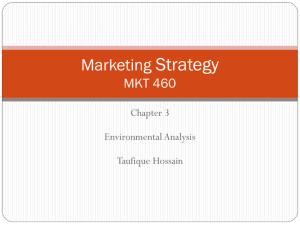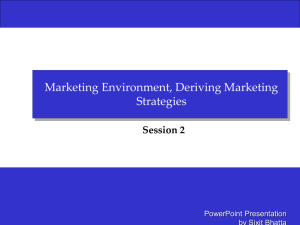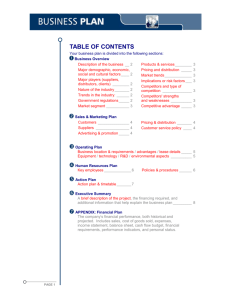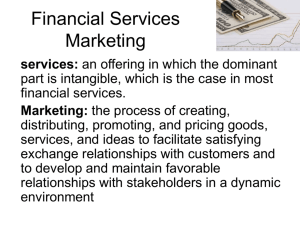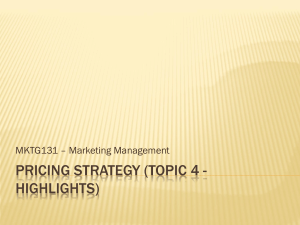Sales & Marketing
advertisement
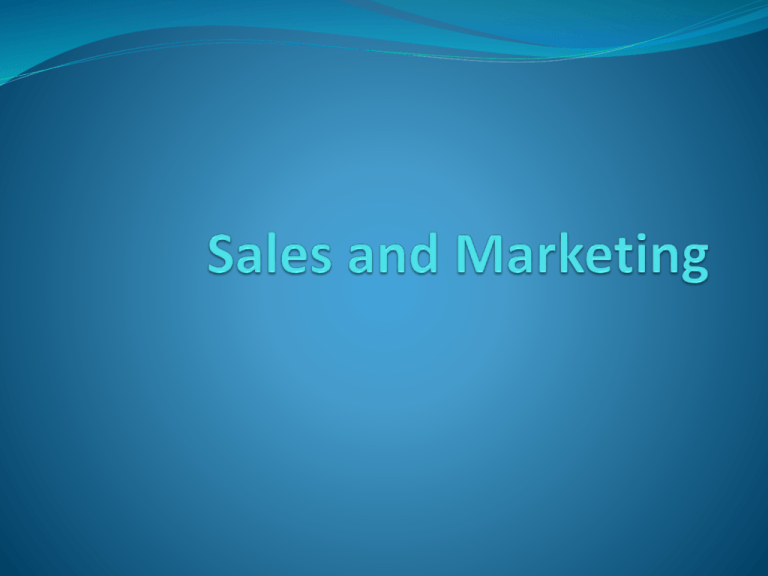
Definitions of Marketing Marketing is the social process by which individuals and groups obtain what they need and want through creating and exchanging products and value with others. Kotler Marketing is the management process that identifies, anticipates and satisfies customer requirements profitably. The Chartered Institute of Marketing The right product, in the right place, at the right time, at the right price. Adcock et al. 2 More Definitions of Marketing Marketing is essentially about marshalling the resources of an organization so that they meet the changing needs of the customer on whom the organization depends. Palmer Marketing is not only much broader than selling, it is not a specialized activity at all. It encompasses the entire business. It is the whole business seen from the point of view of the final result, that is, from the customer’s point of view. Concern and responsibility for marketing must therefore permeate all areas of the enterprise. Drucker This customer focused philosophy is known as the ‘marketing concept’. The marketing concept is a philosophy, not a system of marketing or an organizational structure. It is founded on the belief that profitable sales and satisfactory returns on investment can only be achieved by identifying, anticipating and satisfying customer needs and desires. Barwell 3 Marketing Creating the conditions in which people will buy from you: making (potential) customers aware of the company and its productes; creating the right company image including unique selling points; offering the right products or services; may need to create a market. 4 Market Research Identify your market. How big is it? What’s the competition? What do potential customers want that they haven’t got? 5 SWOT Analysis Used to analyse the position of a company in its market place: Strengths: resources and capabilities that can be used to create a competitive advantage. Weaknesses: absence of some strengths may be a weakness. Opportunities: external factors that might allow the company to expand profitably. Threats: external factors that may threaten the company. 6 Porter’s Five Forces Used to analyse a market: threat of entry power of buyer power of suppliers threat of substitutes competitive rivalry 7 Porter’s Five Forces 8 Threat of new entrants What is the cost of entering the market (e.g. of writing the necessary software)? Are there significant economies of scale (which work against new entrants)? Do existing companies control distribution channels? Can a new entrant gain an advantage through, e.g., specialised knowledge or personal contacts? Will competitors retaliate? How important is the ‘brand’? 9 Power of Buyers high when it’s easy (cheap) to switch between suppliers (e.g. the market for PCs); high where there are a lot of similar suppliers; high where there are only a few buyers, e.g. defence systems. 10 Power of Suppliers high where the switching costs are high e.g. switching from one supplier of accounting software to another; high where the brand is powerful e.g. IBM, Microsoft; buyers are fragmented so they have little bargaining power, e.g. private buyers of new cars. 11 Threat of Substitutes product-for-product substitution e.g. DVD for video cassette; substitution of need e.g. increased range of packages reduces the demand for software development services or availability of music for download reduces demand for CDs; generic substitution (competing for your money or your time) e.g. films on video or DVD competing with books; things that may go out of fashion. 12 Competitive Rivalry High when: entry is easy; the market is profitable suppliers and buyers are struggling to control the market; there is a threat from substitute products. This is why it is always drawn in the centre of the diagram. 13 Marketing – Examples Systems for veterinary practices Web sites for SMEs in Ceredigion 14 Veterinary Practice Software Tristan Veterinary Software (Aberdeen) Vetcom (Dechra Pharmaceuticals, UK) EzeVet (Australian) ImproMed (Wisconsin) VIA (Veterinary Information Assistant) (Elinc)(Texas) DVMax (New York) Vetech Advantage (Illinois) Vetinfo (MDS, Arizona) 15 Functionality Core: Patient records Appointments Billing Optional: Time recording Drugs database Stock control Interface to accounts package. 16 Size of the market The RCVS statistics show some 11,800 vets in full-time practice in the UK. This probably means between 3,000 and 4,000 practices. The RCVS will sell you a mailing list of practices. 17 Market penetration How many practices have computer systems? What proportion of the market does each company hold? What are the usual licensing arrangements and prices? 18 Possible Unique Selling Points Provide a service, as an ASP. Provide help to new customers to switch to your package, e.g. through good conversion utilities or a conversion service. Emphasise that you have a British product aimed at a British market. 19 Analysis power of buyers low; entry into the market is difficult; power of existing suppliers is high. No obvious risk from substitute products (but what about an ASP operation?) Competition? 20 The Marketing Mix Advertisements in the trade press. Demonstrations/stalls at conferences. Papers at conferences. Mail shots. Send demonstration copies to the trade press for review. A month’s trial free of charge. Persuade one or two practices to act as demonstrators, possibly by offering them the software free. 21 Pricing policies Initial licence fee plus annual maintenance and support charge. Annual licence fee, including maintenance and support. Site licence, fee per seat or fee per transaction. 22 Selling to vets practices Ideal scenario: sales prospect identified by interest at conference or returning slip from mail shot; write to prospect, with more information, and saying you will telephone to arrange to visit; visit, with demonstration. You’ll probably have to demonstrate to all the partners separately, so be prepared to spend all day; follow up with formal offer and contract, which practice accepts. 23 Businesses in Ceredigion 3600 VAT registered businesses. 2500 SMEs received support from Objective 1 funding (but probably some double counting). Most probably same receiving Convergence Funds fro EU 24 Some ideas tourism high quality foods crafts. However, most of the well-known ones already have good web sites. 25 The Marketing Mix Local development agencies. Reports in the local press and on local radio. Advertisements in the local press. Sponsorship of local events. 26 Sales Management recruit and train sales staff; plan sales activities; ensure necessary support is available to the sales staff; manage the tension between technical staff and sales staff; monitor performance of sales force; chasing sales situations. 27 The Sales Force Sales people can only sell to people who want to buy. Sales people need to be friendly, sympathetic and not aggressive but they also need perseverance. Sales people need training. Selling is a lonely and stressful activity; it should not be undertaken by anyone inclined to suffer from depression. The bigger the value of the sale, the more important the role of the sales force. 28 Planning Sales Activities identify target customers; gather sales intelligence; find who to talk to; arrange visit; monitor results of visits and plan campaign; visit regularly. 29 What tools does the sales force need? reference sells knowledge of what they are selling web site, brochures, annual reports, etc. ‘boiler-plate’ material support from appropriate technical staff costing information. 30 Sales Metrics potential customers visited; existing customers visited; number of client phone calls; number of contacts; number of appointments set and number conducted; number of new customers; value of order intake. 31 The Sales Visit Objectives: learn more about the company structure; identify the decision makers find out how you could help the company; find out who else in the company to visit; build a good relationship for the future, so that you will always be invited to tender; gossip. 32 Pricing – general factors cost how badly do we need the business? how desirable is the client? may be prepared to reduce the price to win a new and prestigious contract how much does the competition charge? what is the customer’s budget? how much follow-on business will there be? 33 Pricing software products need to balance price against sales volume services provided on a T & M basis prevailing price is important bespoke systems provided at a fixed price high risk. 34 The Sales Package Total cost of ownership over a life time of five or seven years may include: initial purchase, developing bespoke add-ons, installation, training, consultancy, maintenance, support. Some clients may only look at initial purchase price. 35 Package Pricing Example Year 1 Initial licence fee Years 2+ 50,000 Maintenance and support 10,000 Installation 4,000 Consultancy 6,000 3,000 Training 20,000 5,000 Totals 80,000 18,000 36 Pricing – fixed price bespoke estimating is usually inaccurate; try also to estimate the risk; add at least 50% for contingency and to compensate for the risk; may be able to justify a low initial price change payments for long term maintenance and support. 37 Miscellaneous Ask for the order. The role of the sales force does not stop once the sale has been concluded. Cold calling. 38 Elements of a software sales proposal summary; context of the proposal; clear statement of what is to be provided and how it meets the customer’s requirements; contractual basis; costs and time scales; references; company information; CVs of key staff. 39 Proposal Quality show evidence of having read and understood the ITT; correct grammar and spelling, and appropriate style; well produced; addresses all the issues raised in the ITT. If the proposal is full of careless errors, what will the software be like? 40 Producing the Proposal Typically, between 2% and 5% of the value of a small contract is spent on producing a proposal, rather less for larger contracts. Typically, the proposal is written by a team involving sales staff, technical staff and a project manager. Proposals should be: formally approved by the appropriate manager; subject to QA; archived for future reference. 41
